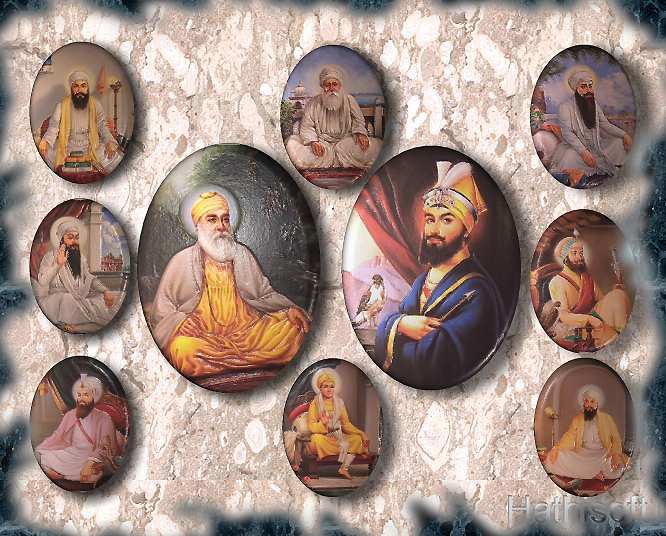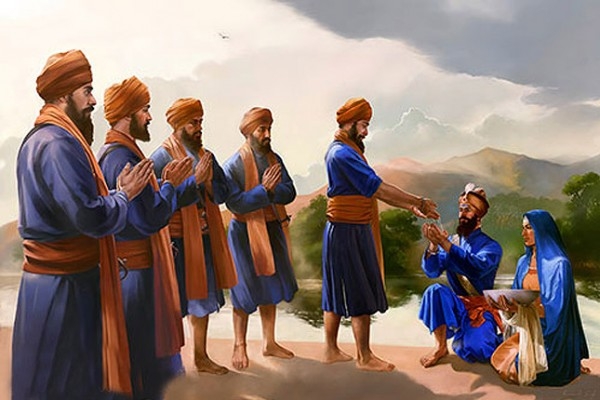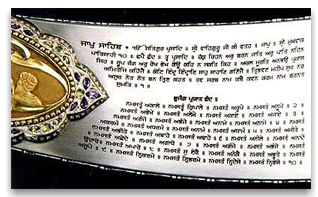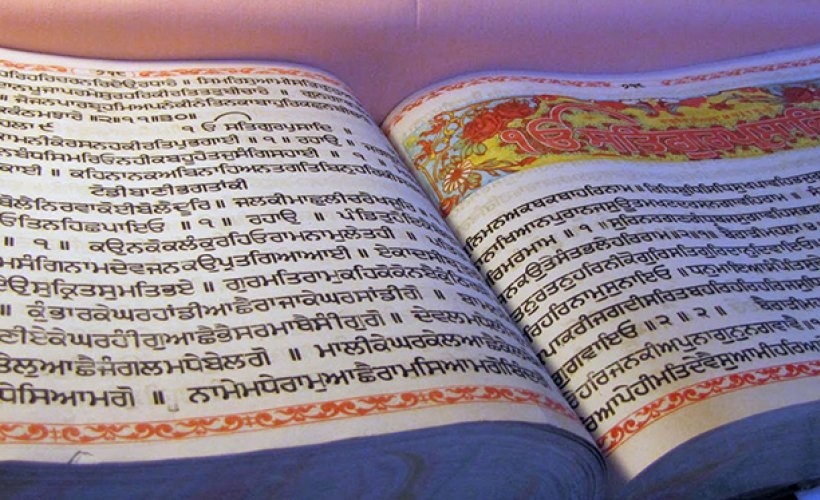 Guru Gobind Singh, born Gobind Rai, was the tenth Sikh Guru, a spiritual master, warrior, poet and philosopher. When his father, Guru Tegh Bahadur, was beheaded for refusing to convert to Islam, Guru Gobind Singh was formally installed as the leader of the Sikhs at age nine, becoming the tenth Sikh Guru
Guru Gobind Singh, born Gobind Rai, was the tenth Sikh Guru, a spiritual master, warrior, poet and philosopher. When his father, Guru Tegh Bahadur, was beheaded for refusing to convert to Islam, Guru Gobind Singh was formally installed as the leader of the Sikhs at age nine, becoming the tenth Sikh Guru
Introduction
For most people a reference to Sikhism will at one evoke an impression of beards, turbans and marital valour. It rarely suggests doctrines of salvation through patient meditation on the divine name, community bhajans, and community service.
Although Sikhism is generally understood to be a simple faith, the definitions which are offered to describe it can be widely and confusingly divergent. Four such definitions are commonly encountered. All four relate primarily to the origins of the faith, each reflecting a specific point of view. For the strictly orthodox Sikh the faith which by preference he calls Gurmat (in contrast to the western term Sikhism) can be regarded as nothing less than the product of direct revelation from God. Gurmat means the Guru’s doctrine.
God, the original Guru, imparted his message to his chosen disciple Nanak who, having intuitively apprehended the message, thereby absorbed the divine spirit and became himself the Guru. This same divine spirit passed at Nanak’s death into the body of his successor, Guru Angad, and in this manner was transferred successively within a series of ten personal Gurus. At the death of the tenth Guru, Guru Gobind Singh, the divine spirit remained present within the sacred scripture and the community of the Guru’s followers. He who accepts the teachings of the Gurus as recorded in the scripture (Guru Granth Sahib) or expressed in the corporate will of the community (panth) is truly a Sikh.
Succession
Beginning with Guru Nanak (1469-1539) the succession of Gurus follows through Guru Angad (1539-1552), Guru Amar Das (1552-1574), Guru Ram Das (1574-1581), Guru Arjan (1581-1606), Guru Hargobind, (1606-1644), Guru Har Rai (1644-1661), Guru Har Krishan (1661-1664), Guru Tegh Badahur (1664-1675) who was beheaded, and had previously announced his successor, Guru Gobind Singh, who was Guru from (1675-1708).

Childhood and Youth
The 10th Guru of the Sikhs, Guru Gobind Singh, was born Gobind Rai in the village of Patna in the eastern province of Bihar. He was the only child of Guru Tegh Bahadur and Mata Gujri was born on the 7th night after the new moon, December 22nd, 1666. Just as all children are reared in the laps of their mothers, the Tenth Guru grew up kicking and playing in the lap of Mata Gujri. His grandmother, Mata Nanaki and his uncle, Kirpal Chand loved and protected him in the early days of his infancy. However his youth was short lived, and he shouldered the responsibility of the Sikh nation when his father was martyred at the hands of the Mughal Emperor in Delhi when he was only nine years old.
Guru Gobind Singh writes in his autobiography, the Bachitar Natik, that he was born into this world with a mission to protect the good and saintly people, and to uproot the tyrants and evil doers. This could only be done by living a life of action, courage, and leadership. As the Guru matured into a man, he exemplified these aspects. He lived amongst his people, not separate from them – a saint and soldier, a man of the world yet a master of the divine. He lead them every step of the way, protecting them from aggression and oppression and sacrificing every facet of his life for the common good. He created the glorious order of the Khalsa out of the common people of the Punjab with unique form that made them stand apart in a crowd of millions.
Creation of the Khalsa
The Amrit Sanskar Ceremony
An open air diwan was held in Kesgarh Sahib at Anandpur. The Guru drew his sword and in a thundering voice said, “I want one head, is there any one who can offer me?”
This most unusual call caused some terror in the gathering and the people were stunned. There was dead silence. The Guru made a second call. Nobody came forward. There was still more silence. On the third call there raised Daya Ram, a khatri of Lahore who said, “O true king, my head is at your service.”
The Guru took Daya Ram by the arm and led him inside a tent. A blow and thud were heard. Then the Guru, with his sword dripping with blood, came out and said, “I want another head, is there anyone who can offer?” Again on third call Dharam Das, a Jat from Delhi came forward and said, “O true king! My head is at thy disposal.”
The Guru took Dharam Das inside the tent, again a blow and thud were heard, and he came out with his sword dripping with blood and repeated, “I want another head, is there any beloved Sikh who can offer it?”
Upon this some people in the assembly remarked that the Guru had lost all reason and went to his mother to complain.
Mohkam Chand, a calico priner/tailor of Dwarka (west coast of India) offered himself as a sacrifice. The Guru took him inside the tent and went through the same process. When he came out, he made a call for the fourth head. The Sikhs began to think that he was going to kill all of them.
Some of them ran away and the others hung their heads down in disbelief. Himmat Chand, a cook of Jagan Nath Puri, offered himself as a fourth sacrifice. Then the Guru made a fifth and the last call for a fifth head. Sahib Chand, a barber of Bidar (in central India), came forward and the Guru took him inside the tent. A blow and thud were heard.
The last time he stayed longer in the tent. People began to breathe with relief. They thought may be the Guru has realised “his mistake” and has now stopped.
The Panj Pyare
The Guru now clad his five volunteers in splendid garments. They had offered their heads to the Guru, and the Guru had now given them himself and his glory. When they were brought outside, they were in the most radiant form. There were exclamations of wonder and the sighs of regret on all sides. Now people were sorry for not offering their heads.
Since the time of Guru Nanak, Charan Pauhal had been the customary form of initiation. People were to drink the holy water which had been touched or washed by the Guru’s toe or feet. The Guru proceeded to initiate them to his new order (Khande di Pauhal) by asking the five faithful Sikhs to stand up.
He put pure water into an iron vessel or Bowl (Batta of Sarbloh) and stirred it with a Khanda (two edged small sword). While stirring the water with Khanda, he recited Gurbani (Five Banis- Japji, Jaap Sahib, Anand Sahib, Swayas, and Chaupai). Sugar crystals called ‘Patasas’ which incidently the Guru’s wife, Mata Sahib Kaur, had brought at that moment, were mixed in the water.

The Guru then stood up with the sacred Amrit (nectar) prepared in the iron bowl. Each of the five faithful, by turn, each kneeling upon his left knee, looked up to the Master to receive the divine amrit. He gave five palmfuls of Amrit to each of them to drink and sprinkled it five times in the eyes, asking them to repeat aloud with each sprinkle, “Waheguru Ji ka Khalsa, Waheguru Ji Ki Fateh.” (This means: Khalsa belongs to God and all triumph be to His Name) Then he anointed with five sprinkles in the hair.
In this way Amrit was administered to the five faithful from the same bowl. After that he asked them to sip Amrit from the same bowl to signify their initiation into the casteless fraternity of the Khalsa. All the five faithful were baptized in this way by the Guru who then called them the ‘PANJ PYARE’ or Five Beloved Ones.
He gave them the appellation of SINGHS (Lions) and they were named from Daya Ram to Daya Singh, Dharam Das to Dharam Singh, Mohkam Chand to Mohkam Singh, Himmat Chand to Himmat Singh, and Sahib Chand to Sahib Singh. The Guru then addressed them as the supreme, the liberated ones, pure ones and he called them THE KHALSA.
He then ordained them to wear the following articles whose names begin with ‘K’:
- Kesh – unshorn hair. This represents the natural appearance of sainthood. This is the first token of Sikh faith.
- Kanga- A comb to clean the hair.
- Kachha – An underwear to indicate virtuous character.
- Kara – A Iron bracelet on the wrist, a symbol of dedication to the Divine Bridegroom.
- Kirpan – A sword symbolising dignity, power and unconquerable spirit.
Jaap Sahib
The Jaap Sahib was written by Guru Gobind Singh, the 10th Guru of the Sikhs. It is the opening bani of the Sri Dasam Granth Sahib, the compiled volume of Guru Gobind Singh’s writings. It is one of the Panj Bania, the daily Sikh prayers, and it is also one of the banis recited at the time of the Amrit Sanchar, the Sikh baptismal ceremony.

Opening Chand of Jaap Sahib
Thou art without any form, symbol, caste, class, or lineage.
None can describe Thy form, hue, garb, or shape.
Eternal and immutable, resplendent in Thine own Light,
Thy Power is without any limit.
Thou art the Lord of all Indras and the King of all kings.
Sovereign of the three worlds,
Mortals, gods, demons,
Even blades of grass in the forests ever proclaim Thou art infinite.
Who can ever recite all Thy names!
Inspired by Thy grace, I recite the names describing Thy deeds.
Bani of Guru Gobind Singh
Bani is short for Gurbani, which is the term used by Sikhs to refer to various sections of text that appear in their scriptures and sacred books. The word Gurbani consists of two roots – Guru and Bani. The word guru means spiritual teacher and here refers to the ten Gurus of Sikhism, the other spiritual leaders and writers whose writings can be found in the Guru Granth. The word Bani refers to their utterances and writings. So the combined word Gurbani means the writings of the Gurus as found in the Sikh scriptures; the Gurus’ words; the Gurus’ teachings.
It is important to note that Guru Gobind Singh referred to God by different names, depending on the topic of the Shabad. Sikhs belive that God has infinite names, given to him by people of different faiths, languages and cultures. He worshipped only in ONE GOD and not any goddesses, gods or others. In fact in the Sikh morning prayer of Jaapji Sahib mention is made of innumerable gods, goddesses, saints, scholars, planets, continents, oceans, suns and moons but there is ONLY one God. Guru Gobind Singh strongly urged his followers to worship only one God and none other.
Translation from Bachiter Natak:

Demise
Wazir Khan of Sirhind had felt concerned at the Emperor’s conciliatory treatment of Guru Gobind Singh. Their marching together to the South made him jealous, and he charged two of his trusted men with murdering the Guru before his increasing friendship with the Emperor resulted in any harm to him. These two pathans Jamshed Khan and Wasil Beg are the names given in the Guru Kian Sakhian pursued the Guru secretly and overtook him at Nanded, where, according to Sri Gur Sobha by Senapati, a contemporary writer, one of them stabbed the Guru in the left side below the heart as he lay one evening in his chamber resting after the Rahrasi prayer. Before he could deal another blow, Guru Gobind Singh struck him down with his sabre, while his fleeing companion fell under the swords of Sikhs who had rushed in on hearing the noise. As the news reached Bahadur Shah’s camp, he sent expert surgeons, including an Englishman, Cole by name, to attend on the Guru. The wound was stitched and appeared to have healed quickly but, as the Guru one day applied strength to pull a stiff bow, it broke out again and bled profusely. This weakened the Guru beyond cure and he passed away on 7 October 1708. Before the end came, Guru Gobind Singh had asked for the Sacred Volume to be brought forth.
To quote Bhatt Vahi Talauda Parganah Jind:
The Annointing of the Guru Granth Sahib
Gobind Singh thus passed on the succession with due ceremony to the Holy Book, the Guru Granth Sahib, ending the line of personal Gurus. “The Guru’s spirit,” he said, “will henceforth be in the Granth and the Khalsa. Where the Granth is with any five Sikhs representing the Khalsa, there will the Guru be.” The Word enshrined in the Holy Book was always revered by the Gurus as well as by their disciples as of Divine origin. The Guru was the revealer of the Word. One day the Word was to take the place of the Guru. The inevitable came to pass when Guru Gobind Singh declared the Guru Granth Sahib as his successor. It was only through the Word that the Guruship could be made everlasting. The Word as contained in the Guru Granth Sahib was henceforth, and for all time to come to be the Guru for the Sikhs.

This page last updated 09 November 2019
This page first updated 11 January 2002
© Saieditor.com
![]()

